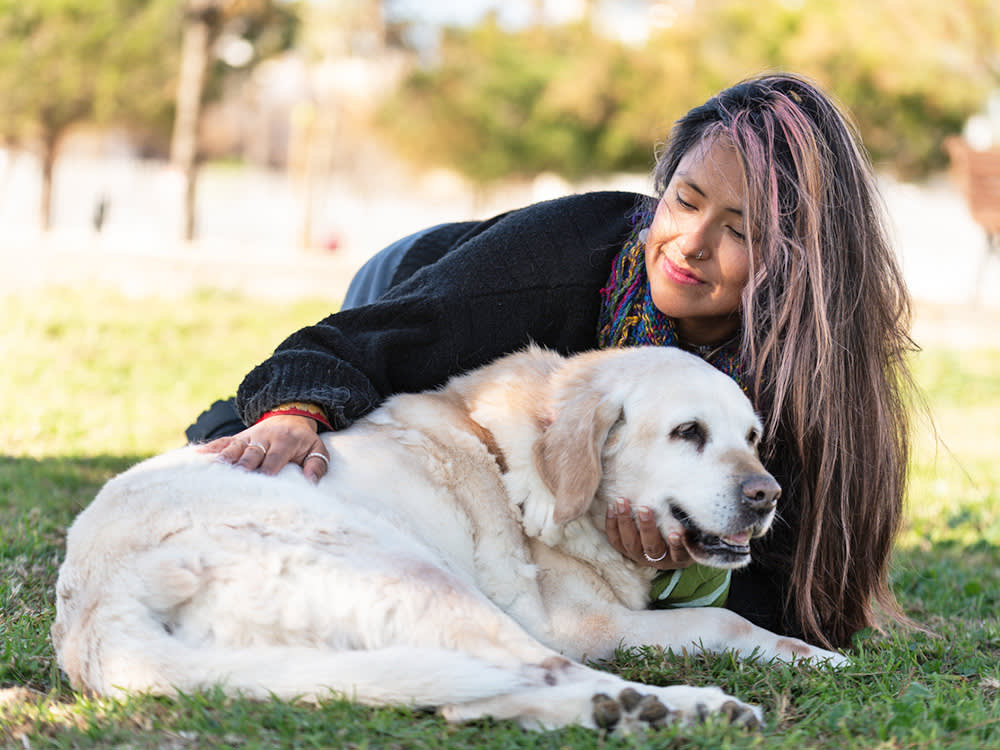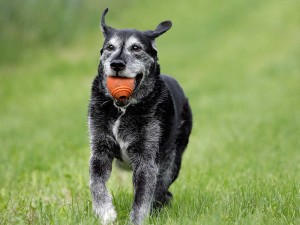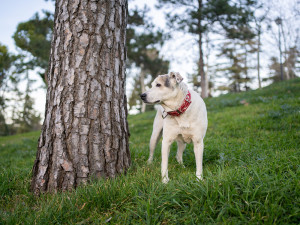How to Identify Hip Dysplasia in Dogs
And how to treat it.

Share Article
In This Article:
What Is Canine Hip Dysplasia?opens in a new tab What Dog Breeds Are Prone to Hip Dysplasia?opens in a new tab Early Signs of Hip Dysplasia in Dogsopens in a new tab Common Signs of Hip Dysplasia in Dogsopens in a new tab
A friend of mine is thinking about adopting a puppy — “A Golden or a Lab. Something big and lovable.” I can't argue with the spectacular cuteness of a Golden Retriever puppy, but as a vet, I have to give the usual disclaimers: “Puppies are a lot of workopens in a new tab. They need lots of vet visits and training. And if you’re getting a large breed, you should plan to check for hip dysplasia — it can be a bummer to deal with.”
“Yikes. How do I find out if a puppy has hip dysplasia?”

littleKin™ is Kinship’s home just for puppy and kitten parents. Bop over to check out expert advice, new pet tools, and special deals—all curated for your newest family member.
opens in a new tabGood question. Let’s talk about it.
What is canine hip dysplasia?
Canine hip dysplasia is an orthopedic condition that affects young, growing dogs and causes the coxofemoral (hip) joint to develop abnormally. Puppies are born with normal hip joints, but as they grow, the hip doesn’t develop properly, leading to increased laxity (looseness). This laxity prevents the ball and socket of the hip joint from fitting together smoothly, which causes degeneration of the bone and cartilage, resulting in early-onset osteoarthritis, also known as degenerative joint disease.
What causes canine hip dysplasia?
Hip dysplasia in canines is a genetic condition, but additional factors like nutrition and growth rate play a role in the severity of the disease. Dogs who are overfed and grow rapidly are more likely to develop hip dysplasia. Studies have shown that a restricted diet can reduce the progression and severity of degenerative joint disease.
Environment, age of neuteringopens in a new tab, and body conformation are also risk factors. For example, puppies who have access to stairs early in life (before three months of age) are at higher risk of developing hip dysplasia. Large-breed dogs who are neutered (or spayed) early can also be at a higher riskopens in a new tab of developing the disease (though pups who are rescued are often fixed early before adoption for understandable reasons). Hip dysplasia is more likely to occur in dogs who are large and stocky.
How is hip dysplasia diagnosed in dogs?
Hip dysplasia is typically diagnosed using a combination of physical exam findings and imaging. Your vet may check for excessive laxity by positioning your puppy’s hip joint a specific way, called the Ortolani test. Radiographs (x-rays) of the hip joint are the most common way to diagnose hip dysplasia in dogs. Both imaging and physical examination may require sedation or anesthesia so that the hips can be positioned properly, especially in dogs who are already experiencing pain.
If your puppy is considered high-risk, your veterinarian may recommend looking for signs of hip dysplasia even if they aren’t having any issues. Signs and symptoms of hip dysplasia in dogs can vary and may not show up until the disease has progressed. Early diagnosis allows for early intervention.
What dog breeds are prone to hip dysplasia?
Hip dysplasia is most common in large- and giant-breed dogs, but body shape is also a risk factor. For example, while Pugs aren’t large, their build makes them prone to hip dysplasia. Hip dysplasia is more likely to occur in dogs who are stocky and stout than those who are thin and lanky. So, Rottweilers are a classic example — Greyhounds, not so much.
Dog breeds that are most affected by hip dysplasia include:
German Shepherd
Labrador Retriever
Golden Retriever
Rottweiler
Great Dane
Newfoundland
Saint Bernand
Bulldogs (American, English, and French)
American Bulldog
Mastiff
Basset Hound
Pug
Corgi
Early signs of hip dysplasia in dogs
Because it is a developmental condition, symptoms may not always be seen right away; however, the beginning signs of hip dysplasia in dogs can show up as early as two to three months of age. The warning signs of hip dysplasia in young dogs are typically detected as behavior changes stemming from hind-limb lameness. These signs can include:
Occasional hind limping (in one or both hind limbs)
“Bunny hopping” with the hind limbs when running or playing
Frequent sitting
Reluctance to run or jump
Being slow to rise
Common signs of hip dysplasia in dogs
Symptoms of hip dysplasia can range from moderate to severe. As the effects of joint degeneration progress, the clinical signs of hip dysplasia in dogs become more severe and more obvious. With time, the symptoms overlap with those of other dogs who have osteoarthritis in their hips. Common signs of canine hip dysplasia include:
Hip pain
Persistent hind limb lameness
Difficulty rising or lying down
Difficulty jumping or talking stairs
Walking with a sway in their hipsopens in a new tab
A “bunny hop” gait in their hind limbs
Audible clicking sounds from their hip joints
Leaning forward to reduce weight on their hind limbs
Muscle atrophy in their hind limbs
When to seek expert help for hip dysplasia
If you’re concerned that your dog is experiencing pain or seems to be walking funny, your vet may recommend diagnostics to rule out hip dysplasia, especially if your dog is young. If you adopt a high-risk dog, it’s a good idea to chat with your vet about early monitoring for hip dysplasia so that it can be caught before problems develop. Early diagnosis allows for early intervention — sometimes before arthritis develops — reducing pain and improving your pup’s quality of life.
There are medical and surgical treatment options for canine hip dysplasia.
Medical management
Medical management often involves a combination of medications and lifestyle adjustmentsopens in a new tab. Weight management is a key part of treatmentopens in a new tab and must be a priority for overweight dogs. Maintaining a lean body weight reduces pressure and stress on the hip joints.
Appropriate exercise is also important to maintain strength without causing additional stress in the joints. Swimming is a popular, low-impact option. Dogs can also benefit from physical therapy exercises that maintain range of motion and muscle strength.
Joint supplements can help protect the cartilage and reduce pain associated with osteoarthritisopens in a new tab. Oral products are popularopens in a new tab, but your vet may recommend injectable joint protectants as well. Common oral joint supplement ingredients include glucosamineopens in a new tab, chondroitin, omega-3 fatty acidsopens in a new tab, and green-lipped mussel extract. Even though many of these products are available over the counter, you should always check with your vet before starting them.
Prescription pain medications can help with the inflammation and discomfort associated with hip dysplasia. Non-steroidal anti-inflammatory drugs (NSAIDs) are a common first choice, but there are additional pain medication options if needed.
Some dog parents have seen success with supplemental treatments like acupunctureopens in a new tab and stem-cell therapyopens in a new tab.
Surgical treatment
Surgical treatment options for canine hip dysplasia vary depending on the age of the dog and the severity of the disease. Some surgeries are performed to preserve the hip joint, while others are considered “salvage procedures” — performed to improve the dog’s quality of life.
A juvenile pubic symphysiodesis (JPS) is a surgery performed to reduce the laxity of the hip joint in young dogs. The goal is to prevent or lessen future degenerative joint disease. JPS surgery must be done before a puppy is five months old, highlighting the importance of early diagnosis.
Double or triple pelvic osteotomy (DPO/TPO) surgery is also performed in young dogs who have hip dysplasia but have yet to develop osteoarthritis. The goal of this procedure is to correct the alignment of the hip joint (make the ball and socket smoother) to prevent or reduce the friction that leads to degeneration. This option is typically performed on puppies between the ages of five and 10 months.
Total hip replacement surgery is considered a salvage procedure and is typically performed on dogs with severe degenerative joint disease and who are no longer responding to medical management. In this procedure, both the ball and socket of the hip joint are replaced with implants.
Femoral head ostectomy (FHO) is a salvage procedure in which the ball of the ball and socket is removed. The goal of this procedure is to eliminate the pain caused by friction in the hip joint. An FHO is a less expensive surgery than a total hip replacement, but it is typically only recommended for dogs that weigh less than 45 pounds and have severe disease in only one hind limb.
Spay or neuter surgery should also be part of the treatment plan for dogs with hip dysplasia. Although castration will not help with their disease, dogs with hip dysplasia should not be bred.
Bottom line
Canine hip dysplasia is an orthopedic condition that causes laxity, and eventually, degeneration of the hip joint. Large and giant breed dogs are most commonly affected, but small, stocky dogs can be affected, too. Symptoms tend to overlap with those seen on dogs who have osteoarthritis in the hipsopens in a new tab, including hind-limb lameness and reluctance to run, jump, or even go for a walkopens in a new tab. There are both medical and surgical treatment options. Early diagnosis is key to preventing severe joint degeneration.
References
Cohn, Leah A, and Etienne Côté. Côté’s Clinical Veterinary Advisor. Dogs and Cats. 4th ed., St. Louis, Mo., Elsevier, 2020.
“Hip Dysplasia.” OFA, ofa.org/diseases/hip-dysplasia/opens in a new tab.
Krontveit, Randi I., et al. “A Prospective Study on Canine Hip Dysplasia and Growth in a Cohort of Four Large Breeds in Norway (1998–2001).” Preventive Veterinary Medicine, vol. 97, no. 3-4, Dec. 2010, pp. 252–263, https://doi.org/10.1016/j.prevetmed.2010.09.015opens in a new tab.

Dr. Alycia Washington, DVM, MS
Alycia Washington, DVM, is a small animal emergency veterinarian based in North Carolina. She works as a relief veterinarianopens in a new tab and provides services to numerous emergency and specialty hospitals. Dr. Washington is also a children’s book author and freelance writer with a focus on veterinary medicine. She has a special fondness for turtles, honey bees, and penguins — none of which she treats. In her free time, Dr. Washington enjoys travel, good food, and good enough coffee.
Related articles
![]() opens in a new tab
opens in a new tabStem Cell Therapy For Dogs: Everything You Need to Know
This innovative treatment has its pros and cons — but it may be an effective treatment for conditions like osteoarthritis.
![Older dog playing with ball in a green field]() opens in a new tab
opens in a new tabDog Arthritis Treatment: How to Relieve Arthritis Pain in Dogs
Tips for treating achy joints — from medications to massages.
![Happy golden retriever dog on a walk with owner in woodsy yellow and orange fall setting with leaves on the dirt trail.]() opens in a new tab
opens in a new tabHome Remedies for Dog Joint Pain Relief
DIY ways to help your pup cope with the pain.
- opens in a new tab
Why Does My Dog Sigh?
They truly act like the weight of the world is on their shoulders.
![A senior white dog with arthritis wearing a red collar standing by a large tree in the grass outside]() opens in a new tab
opens in a new tabMedication For Dog Arthritis: Dog Arthritis Pain Management
Hope for dogs with arthritis is on the horizon.
![Sad looking white boxer sitting on a chair at a wooden table]() opens in a new tab
opens in a new tabHow to Help Your Dog with Degenerative Myelopathy
The disease inhibits your dog's ability to use their legs. One writer shares how the condition is diagnosed — and how you can help your dog stay mobile.







